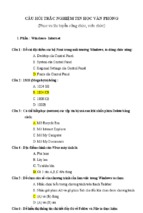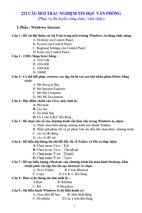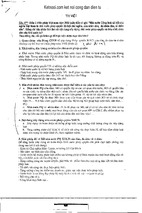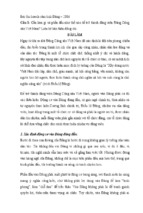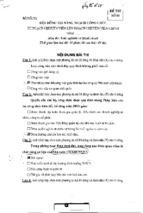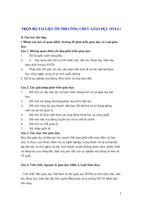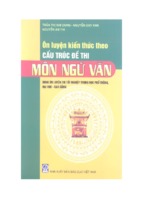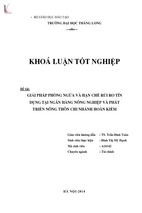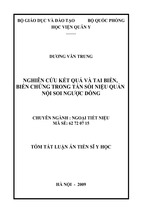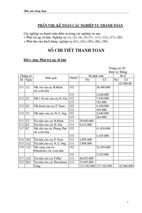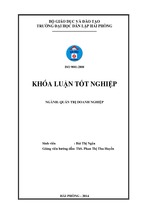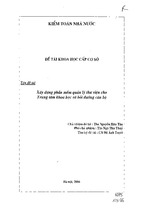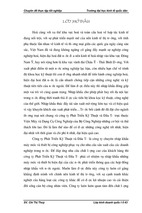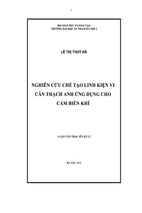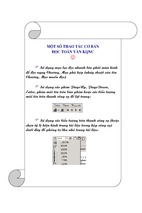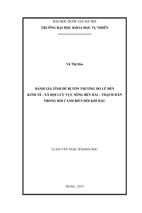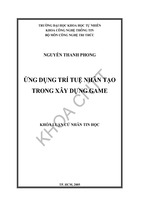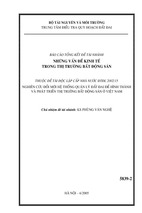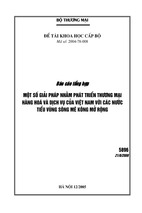PREFACE
English for Drug Development and Production Major is intended for senior students
whose major is pharmaceutical development and production. The book incorporates
linguistic skills, pharmacy-related vocabulary and specialized knowledge.
English for Drug Development and Production Major has been specifically compiled
to equip learners with necessary skills and knowledge to understand significant
pharmacy-related materials. The content of this book covers WHO guidelines for
pharmaceutical production and development, USP monograph, physio-chemical
properties of some excipients, manufacturing processes, package inserts and journals
of pharmaceutical science.
With an effort of making the textbook an efficient aid in this ESP course, the compilers will
be greatly indebted for all constructive feedback or up-to-date information sent to the
General English Department of Lac Hong University via
[email protected].
i
TABLE OF CONTENTS
Page
PREFACE ..................................................................................................................... i
TABLE OF CONTENTS ............................................................................................. ii
UNIT 1
WHO good manufacturing practices for pharmaceutical products:
main principles ........................................................................................... 1
UNIT 2
WHO good manufacturing practices for pharmaceutical products:
Documentation and good practices in production ...................................... 9
UNIT 3
Pharmaceutical development and production team .................................. 25
UNIT 4
USP Monograph on Dosage Forms .......................................................... 34
UNIT 5
Quality Control Tests For Dosage Forms ................................................. 47
UNIT 6
USP Monograph on Technical Specifications of an Active Substance ..... 61
UNIT 7
Physico- chemical properties of an excipient ........................................... 71
UNIT 8
Manufacturing process of a coated tablets and sustained release tablets ...... 82
UNIT 9
Manufacturing process of liquid products/cream ..................................... 89
UNIT 10
Package Inserts ......................................................................................... 98
UNIT 11
Asian Journal of Pharmaceutical Sciences ............................................. 103
A GLOSSARY OF DOSAGE FORMS .................................................................. 127
ABBREVIATIONS .................................................................................................. 134
VOCABULARY ....................................................................................................... 149
ii
UNIT 1
WHO GOOD MANUFACTURING PRACTICES FOR
PHARMACEUTICAL PRODUCTS
MAIN PRINCIPLES
SCRUB UP
1. Work with a partner to match each phonetic spelling with its word and try to say it
with your partner.
/ˈstɔːrɪdʒ/
manufacturing
/ˈfɑːməsi/
/ˈlæbrətɔːri/
distribution
laboratory
/ˌdɪstrɪˈbjuːʃn/
/ˌmænjuˈfæktʃərɪŋ/
storage
pharmacy
2. Each word above represents an area of good practice. Read the definition of GxP
and write the full form of each following abbreviation under its suitable picture.
GxP is a general term for quality guidelines, standards and regulations of Good
Practice. These guidelines are predominantly used in the pharmaceutical industry
and medical device industry.
GDP - GLP - GPP - GMP - GSP
1. ________________
__________________
2. ________________
__________________
4. ____________________________
______________________________
3. _________________
___________________
5. __________________________
____________________________
1
READING COMPREHENSION
Good Manufacturing Practices for Pharmaceutical Products
GMP is that part of quality management which ensures that products are consistently
produced and controlled according to the quality standards appropriate to their
intended use and as required by the marketing authorization, clinical trial authorization
or product specification. GMP is concerned with both production and QC. GMP is
aimed primarily at managing and minimizing the risks inherent in pharmaceutical
manufacture to ensure the quality, safety and efficacy of products. Under GMP:
(a)
all manufacturing processes are clearly defined, systematically reviewed for
associated risks in the light of scientific knowledge and experience, and shown
to be capable of consistently manufacturing pharmaceutical products of the
required quality that comply with their specifications;
(b)
qualification and validation are performed;
(c)
all necessary resources are provided, including:
sufficient and appropriately qualified and trained personnel,
adequate premises and space,
suitable equipment and services,
appropriate materials, containers and labels,
approved procedures and instructions,
suitable storage and transport,
adequate personnel, laboratories and equipment for in-process controls;
(d)
instructions and procedures are written in clear and unambiguous language,
specifically applicable to the facilities provided;
(e)
procedures are carried out correctly and personnel are trained to do so;
(f)
records are made (manually and/or by recording instruments) during
manufacture to show that all the steps required by the defined procedures and
instructions have in fact been taken and that the quantity and quality of
products are as expected. Any significant deviations are fully recorded and
investigated with the objective of determining the root cause and appropriate
corrective and preventive action is implemented;
(g)
records covering manufacture and distribution, which enable the complete
history of a batch to be traced, are retained in a comprehensible and accessible
form;
2
(h)
the proper storage and distribution of the products minimizes any risk to their
quality and takes account of good distribution practices;
(i)
a system is available to recall any batch of product from sale or supply;
(j)
complaints about marketed products are examined, the causes of quality defects
investigated and appropriate measures taken in respect of the defective products
to prevent recurrence.
EXERCISE 1
Join these word combinations used in the text.
1. associated
2. required
a. products
b. risks
3. trained
c. distribution
4. suitable
5. approved
d. action
e. cause
6. in-process
7. root
8. preventive
9. proper
10. marketed
f.
g.
h.
i.
j.
EXERCISE 2
controls
procedures
services
personnel
quality
Complete the following sentences with the correct word or
expression in bold from the text.
1. There should be written ________________ describing the action to be taken,
including the need to consider a recall, in the case of a complaint concerning a possible
product defect.
2. If a product defect is discovered or suspected in _____________, consideration
should be given to whether other batches should be checked in order to determine
whether they are also affected.
3. All competent authorities of all countries to which a given product has been
distributed should be promptly informed of any intention to _____________ the
product because it is, or is suspected of being, defective.
4. The person responsible for QC should have responsibility, together with other
relevant departments, for approving suppliers who can reliably supply starting and
packaging materials that meet established _______________.
3
5. The function of the approval of the release of a finished batch or a product can be
delegated to a designated person with appropriate qualifications and experience who
will release the product in accordance with a(n) ______________ procedure.
6. Any person shown at any time to have an apparent illness or open lesions that may
adversely affect the __________________ should not be allowed to handle starting
materials, packaging materials, in-process materials or medicines until the condition is
no longer judged to be a risk.
7. To ________________ protection of the product from contamination, personnel
should wear clean body coverings appropriate to the duties they perform, including
appropriate hair covering.
8. All _____________ should be trained in the practices of personal hygiene. A high
level of personal hygiene should be observed by all those concerned with
manufacturing processes.
9. ______________ equipment should be withdrawn from use until the defect has been
rectified.
10. The _______________ records should be readily available to the authorized
person, and they should contain sufficient information on wholesalers and directly
supplied customers (including, for exported products, those who have received
samples for clinical tests and medical samples) to permit an effective recall.
TRANSLATION
Translate the following texts into Vietnamese.
1. Storage areas should be designed or adapted to ensure good storage conditions. In
particular, they should be clean, dry, sufficiently lit and maintained within acceptable
temperature limits. Where special storage conditions are required (e.g. temperature,
humidity) these should be provided, controlled, monitored and recorded where
appropriate.
2. In order to minimize the risk of a serious medical hazard due to crosscontamination, dedicated and self-contained facilities must be available for the
production of particular pharmaceutical products, such as highly sensitizing materials
(e.g. penicillins) or biological preparations (e.g. live microorganisms). The production
4
of certain other highly active products, such as some antibiotics, hormones, cytotoxic
substances and certain non-pharmaceutical products, should not be conducted in the
same facilities. In exceptional cases, the principle of campaign working in the same
facilities can be accepted provided that specific precautions are taken and the
necessary validations (including cleaning validation) are made. The manufacture of
technical poisons, such as pesticides and herbicides, should not be allowed in premises
used for the manufacture of pharmaceutical products.
3. Starting materials in the storage area should be appropriately labelled. Labels should
bear at least the following information:
(a) the designated name of the product and the internal code reference where
applicable;
(b) the batch number given by the supplier and, on receipt, the control or batch
number given by the manufacturer, if any, documented so as to ensure
traceability;
(c) the status of the contents (e.g. in quarantine, on test, released, rejected, returned,
recalled);
(d) where appropriate, an expiry date or a date beyond which retesting is necessary.
When fully validated computerized storage systems are used, not all of the above
information need be in a legible form on the label.
SELF-STUDY
EXERCISE 1
Read the text and complete it using words from below.
investigated
one-off
minimize
defective
validated
cross-contamination
segregated area
corrective action
solvents
detect
routinely
first-expire
eliminated
qualified
quarantined
5
WHO Good Manufacturing Practices for Pharmaceutical Products:
Main Principles
A- In accordance with GMP, each pharmaceutical company should identify what
qualification and validation work is required to prove that the critical aspects of their
particular operation are controlled. Any aspect of operation, including significant
changes to the premises, facilities, equipment or processes, which may affect the
quality of the product, directly or indirectly, should be qualified and ____________(1).
Qualification and validation should not be considered as _____________(2) exercises.
An on-going programme should follow their first implementation and should be based
on an annual review.
Particular attention should be paid to the validation of analytical test methods,
automated systems and cleaning procedures.
B- A high level of sanitation and hygiene should be practised in every aspect of the
manufacture of medicines. The scope of sanitation and hygiene covers personnel,
premises, equipment and apparatus, production materials and containers, products for
cleaning and disinfection, and anything that could become a source of contamination
to the product. Potential sources of contamination should be ______________ (3)
through an integrated comprehensive programme of sanitation and hygiene.
C- All complaints and other information concerning potentially defective products
should
be
carefully
reviewed
according
to
written
procedures
and
the
______________ (4) should be taken.
Any complaint concerning a product defect should be recorded with all the original
details and thoroughly ______________(5). The person responsible for QC should
normally be involved in the review of such investigations.
D- There should be a system to recall from the market, promptly and effectively,
products known or suspected to be ______________(6). An instruction should be
included in the written procedures to store recalled products in a secure
______________ (7) while their fate is decided.
6
The distribution records should be readily available to the authorized person, and they
should contain sufficient information on wholesalers and directly supplied customers
(including, for exported products, those who have received samples for clinical tests
and medical samples) to permit an effective recall.
E- The purpose of self-inspection is to evaluate the manufacturer‘s compliance with
GMP in all aspects of production and QC. The self-inspection programme should be
designed to ______________ (8) any shortcomings in the implementation of GMP and
to recommend the necessary corrective actions. Self-inspections should be performed
______________(9), and may be, in addition, performed on special occasions, e.g. in
the case of product recalls or repeated rejections, or when an inspection by the health
authorities is announced. The team responsible for self-inspection should consist of
personnel who can evaluate the implementation of GMP objectively. All
recommendations for corrective action should be implemented. The procedure for selfinspection should be documented, and there should be an effective follow-up
programme.
F- The establishment and maintenance of a satisfactory system of QA and the correct
manufacture and control of pharmaceutical products and active ingredients rely upon
people. For this reason there must be sufficient ______________ (10) personnel to
carry out all the tasks for which the manufacturer is responsible. Individual
responsibilities should be clearly defined and understood by the persons concerned and
recorded as written descriptions.
G- Premises and equipment must be located, designed, constructed, adapted and
maintained to suit the operations to be carried out. The layout and design of equipment
must aim to ______________ (11) the risk of errors and permit effective cleaning and
maintenance in order to avoid ______________ (12), build-up of dust or dirt, and, in
general, any adverse effect on the quality of products.
H- The main objective of a pharmaceutical plant is to produce finished products for
patients‘ use from a combination of materials (starting and packaging). Materials
including starting materials, packaging materials, gases, ______________ (13),
process aids, reagents and labelling materials.
7
No materials used for operations such as cleaning, lubrication of equipment and pest
control should come into direct contact with the product. Where possible, such
materials should be of a suitable grade (e.g. food grade) to minimize health risks.
All incoming materials and finished products should be ______________ (14)
immediately after receipt or processing, until they are released for use or distribution.
All materials and products should be stored under the appropriate conditions
established by the manufacturer, and in an orderly fashion, to permit batch segregation
and stock rotation by a ______________ (15) first-out rule.
Water used in the manufacture of pharmaceutical products should be suitable for its
intended use.
EXERCISE 2
Choose the best headings (1-8) to match the sections of the text
above (A-H).
______ 1.
______ 2.
Materials
Premises and equipment
______ 3.
______ 4.
Personnel
Self-inspection, quality audits and suppliers‘ audits and approval
______ 5.
______ 6.
Sanitation and hygiene
Product recalls
______ 7.
______ 8.
Complaints
Qualification and validation
EXERCISE 3
Answer these questions about the text.
1. What does the scope of sanitation and hygiene cover?
2. How often should self-inspections be performed? What is the purpose of selfinspection?
3. What should the distribution records contain? Why?
8
UNIT 2
DOCUMENTATION AND GOOD PRACTICE
IN PRODUCTION
SCRUB UP
Match each word with its definition.
a. batch
___1. a fixed working method, often written down
b. audit trail
___2. the status of starting of packaging materials, intermediate,
bulk or finished products isolated physically or by other effective
means whilst awaiting a decision on their release or refusal
c. mix-up
___3. the elimination or control of an insect or animal that attacks
crops, food, livestock, etc.
d. specification
___4. the process by which bacteria or other microorganisms are
unintentionally transferred from one substance or object to
another, with harmful effect
e. calibrate
___5. an amount of medicine produced at one time
f. crosscontamination
___6. all operations, including filling and labelling, which a bulk
product has to undergo in order to become a finished product
g. periodic
___7. correlate the readings of an instrument with those of a
standard in order to check the instrument's accuracy
h. formulae
___8. a list of ingredients for or constituents of something
i. pest control
___9. appearing or occurring at fixed intervals
j. packaging
___10. a written account of something that is kept so that it can be
looked at or used in the future
k. quarantine
___11. a confusion of one thing with another, or a misunderstanding
or mistake that results in confusion
l. standard
operating
procedure
___12. the ability to verify the history, location, or application of an
item by means of documented recorded identification
m. traceability
___13. the detailed record of information on paper or on a computer
that can be examined to prove what happened
n. documentation
___14. the practice of making sure that goods and services fulfil
defined standards
o. quality assurance
___15. a detailed description of the design and materials used to
make something
p. record
___16. the paperwork that is required for something or that gives
evidence or proof of something
9
READING COMPREHENSION
Principle
Good documentation is an essential part of the quality assurance system and, as such,
should exist for all aspects of GMP. Its aims are to define the specifications and
procedures for all materials and methods of manufacture and control; to ensure that all
personnel concerned with manufacture know what to do and when to do it; to ensure
that authorized persons have all the information necessary to decide whether or not to
release a batch of a medicine for sale; to ensure the existence of documented evidence,
traceability, and to provide records and an audit trail that will permit investigation. It
ensures the availability of the data needed for validation, review and statistical
analysis. The design and use of documents depend upon the manufacturer. In some
cases, some or all of the documents described below may be brought together, but they
will usually be separate.
Documents required
1. Labels
Labels applied to containers, equipment or premises should be clear, unambiguous and
in the company‘s agreed format. It is often helpful in addition to the wording on the
labels to use colours to indicate status (e.g. quarantined, accepted, rejected, clean).
For reference standards, the label and/or accompanying document should indicate
potency or concentration, date of manufacture, expiry date, date the closure is first
opened, storage conditions and control number, as appropriate.
2. Specifications and testing procedures
Testing procedures described in documents should be validated in the context of
available facilities and equipment before they are adopted for routine testing.
There should be appropriately authorized and dated specifications, including tests on
identity, content, purity and quality, for starting and packaging materials and for
finished products; where appropriate, they should also be available for intermediate or
bulk products. Specifications for water, solvents and reagents (e.g. acids and bases)
used in production should be included.
Each specification should be approved, signed and dated, and maintained by the QC or
QA units.
Periodic revisions of the specifications may be necessary to comply with new editions
of the national pharmacopoeia or other official compendia.
Pharmacopoeias, reference standards, reference spectra and other reference materials
should be available in the QC laboratory.
10
3. Master formulae
A formally authorized master formula should exist for each product and batch size to
be manufactured.
4. Packaging instructions
Formally authorized packaging instructions should exist for each product, pack size
and type.
5. Standard operating procedures and records
SOPs and associated records of actions taken or, where appropriate, conclusions
reached should be available for:
(a)
equipment assembly and validation;
(b)
(c)
(d)
(e)
(f)
(g)
(h)
analytical apparatus and calibration;
maintenance, cleaning and sanitization;
personnel matters including qualification, training, clothing and hygiene;
environmental monitoring;
pest control;
complaints;
recalls;
(i)
returns.
There should be SOPs for the internal labelling, quarantine and storage of starting
materials, packaging materials and other materials, as appropriate.
SOPs should be available for each instrument and piece of equipment (e.g. use,
calibration, cleaning, maintenance) and placed in close proximity to the equipment.
There should be SOPs for sampling, which specify the person(s) authorized to take
samples.
There should be an SOP describing the details of the batch (lot) numbering system,
with the objective of ensuring that each batch of intermediate, bulk or finished product
is identified with a specific batch number.
The SOPs for batch numbering that are applied to the processing stage and to the
respective packaging stage should be related to each other.
The SOP for batch numbering should ensure that the same batch numbers will not be
used repeatedly; this applies also to reprocessing.
11
Batch-number allocation should be immediately recorded, e.g. in a logbook. The
record should include at least the date of allocation, product identity and size of batch.
There should be written procedures for testing materials and products at different
stages of manufacture, describing the methods and equipment to be used. The tests
performed should be recorded.
Written release and rejection procedures should be available for materials and
products, and in particular for the release for sale of the finished product by an
authorized person.
Records should be maintained of the distribution of each batch of a product in order,
for example, to facilitate the recall of the batch if necessary.
Records should be kept for major and critical equipment, as appropriate, of any
validations, calibrations, maintenance, cleaning or repair operations, including dates
and the identity of the people who carried out these operations.
The use of major and critical equipment and the areas where products have been
processed should be appropriately recorded in chronological order.
There should be written procedures assigning responsibility for cleaning and sanitation
and describing in sufficient detail the cleaning schedules, methods, equipment and
materials to be used and facilities and equipment to be cleaned. Such written
procedures should be followed.
EXERCISE 1
Match each document below (A-H) with its required
information (1-9).
A. Master formulae ______
B. Analysis records ______
C. Specifications for starting and packaging materials and specifications for
intermediate and bulk products ______
D. Specifications for finished products _____
E. Packaging instructions _____
F. Labels _____
G. Batch packaging records _____
H. Batch processing records _____
I. The records for the receipt of each delivery of starting material and primary
and printed packaging material _____
12
1.
(a)
the name of the medicines;
(b)
a list of the active ingredients (if applicable, with the INN), showing the amount
of each present and a statement of the net contents (e.g. number of dosage units,
weight, volume);
(c)
(d)
(e)
the batch number assigned by the manufacturer;
the expiry date in an uncoded form;
any special storage conditions or handling precautions that may be necessary;
(f)
directions for use, and warnings and precautions that may be necessary;
(g)
the name and address of the manufacturer or the company or the person
responsible for placing the product on the market.
2.
(a)
(b)
(c)
the INN and internal code reference;
the reference, if any, to a pharmacopoeial monograph;
qualitative and quantitative requirements with acceptance limits.
Depending on the company‘s practice, other data may be added to the specification, such as:
the supplier and the original producer of the materials;
a specimen of printed materials;
directions for sampling and testing, or a reference to procedures;
storage conditions and precautions;
the maximum period of storage before reexamination.
3.
(a)
(b)
(c)
(d)
(e)
(f)
(g)
the designated name of the product and the code reference, where applicable;
the designated name(s) of the active ingredient(s) (if applicable, with the
INN(s));
the formula or a reference to the formula;
a description of the dosage form and package details;
directions for sampling and testing or a reference to procedures;
the qualitative and quantitative requirements, with acceptance limits;
the storage conditions and precautions, where applicable;
4.
(a) the name of the product, with a product reference code relating to its specification;
(b) a description of the dosage form, strength of the product and batch size;
(c) a list of all starting materials to be used (if applicable with the INNs), with the
amount of each, described using the designated name and a reference that is
unique to that material (mention should be made of any substance that may
disappear in the course of processing);
13
(d) a statement of the expected final yield with the acceptable limits, and of relevant
intermediate yields, where applicable;
(e) a statement of the processing location and the principal equipment to be used;
(f) the methods, or reference to the methods, to be used for preparing and operating
the critical equipment, e.g. cleaning (especially after a change in product),
assembling, calibrating, sterilizing, use;
(g) detailed step-wise processing instructions (e.g. checks on materials, pretreatments,
sequence for adding materials, mixing times, temperatures);
(h) the instructions for any in-process controls with their limits;
(i) where necessary, the requirements for storage of the products, including the
container, the labelling, and any special storage conditions;
(j) any special precautions to be observed.
5.
(a) the name of the product;
(b) a description of its pharmaceutical form, strength and, where applicable, method
of application;
(d) the pack size expressed in terms of the number, weight or volume of the product in
the final container; materials required for a standard batch size, including
quantities, sizes and types, with the code or reference number relating to the
specifications for each packaging material;
(e) where appropriate, an example or reproduction of the relevant printed packaging
materials and specimens, indicating where the batch number and expiry date of the
product have been marked;
(f) special precautions to be observed, including a careful examination of the
packaging area and equipment in order to ascertain the line clearance before and
after packaging operations;
(g) a description of the packaging operation, including any significant subsidiary
operations, and equipment to be used;
(h) details of in-process controls with instructions for sampling and acceptance limits.
6.
(a)
(b)
(c)
(d)
(f)
14
the name of the product;
the number of the batch being manufactured;
dates and times of commencement, of significant intermediate stages, and of
completion of production;
the name of the person responsible for each stage of production;
the initials of the operator(s) of different significant steps of production and, where
appropriate, of the person(s) who checked each of these operations (e.g. weighing);
the batch number and/or analytical control number and the quantity of each
starting material actually weighed (including the batch number and amount of
any recovered or reprocessed material added);
(g)
(h)
any relevant processing operation or event and the major equipment used;
the in-process controls performed, the initials of the person(s) carrying them
(i)
out, and the results obtained;
the amount of product obtained at different and pertinent stages of manufacture
(yield), together with comments or explanations for significant deviations from
the expected yield;
(j)
notes on special problems including details, with signed authorization for any
deviation from the master formula.
7.
(a) the name of the product, the batch number and the quantity of bulk product to be
packed, as well as the batch number and the planned quantity of finished product
that will be obtained, the quantity actually obtained and the reconciliation;
(b) the date(s) and time(s) of the packaging operations;
(c) the name of the responsible person carrying out the packaging operation;
(d) the initials of the operators of the different significant steps;
(e) the checks made for identity and conformity with the packaging instructions,
including the results of in-process controls;
(f) details of the packaging operations carried out, including references to equipment
and the packaging lines used, and, when necessary, the instructions for keeping the
product if it is unpacked or a record of returning product that has not been
packaged to the storage area;
(g) whenever possible, samples of the printed packaging materials used, including
specimens bearing the approval for the printing of and regular check (where
appropriate) of the batch number, expiry date, and any additional overprinting;
(h) notes on any special problems, including details of any deviation from the
packaging instructions, with written authorization by an appropriate person;
(i) the quantities and reference number or identification of all printed packaging
materials and bulk product issued, used, destroyed or returned to stock and the
quantities of product obtained to permit an adequate reconciliation.
8.
(a)
(b)
(c)
(d)
the name of the material on the delivery note and the containers;
the ―in-house‖ name and/or code of material if different from (a);
the date of receipt; the supplier‘s name and, if possible, manufacturer‘s name;
the manufacturer‘s batch or reference number;
15
(e) the total quantity, and number of containers received;
(f) the batch number assigned after receipt;
(g) any relevant comment (e.g. state of the containers).
9.
(a) the name of the material or product and, where applicable, dosage form;
(b) the batch number and, where appropriate, the manufacturer and/or supplier;
(c) references to the relevant specifications and testing procedures;
(d) test results, including observations and calculations, and reference to any
specifications (limits);
(e) date(s) and reference number(s) of testing;
(f) the initials of the persons who performed the testing;
(g) the date and initials of the persons who verified the testing and the calculations,
where appropriate;
(h) a clear statement of release or rejection (or other status decision) and the dated
signature of the designated responsible person.
16
EXERCISE 2
Write the verbs (in past participle form) used in these
expressions. Then read the text and required information in
exercise 1 again to check and translate these expressions into
Vietnamese.
English expressions
e.g.: Documents required
Vietnamese meaning
Các tài liệu cần thiết
1. conclusions __________
2. actions __________
3. __________ person
4. __________ products
5. __________ format
6. a specimen of __________ materials
7. all of the documents __________
8. the availability of the data __________
for validation
9. written procedures should be
__________
10. the in-process controls __________
11. the total quantity, and number of
containers __________
12. details of the packaging operations
__________ out
13. the batch number __________ by the
manufacturer
17
14. all personnel __________ with
manufacture
15. specifications for water, solvents and
reagents __________ in production
16. labels __________ to containers,
equipment or premises
17. the amount of product __________ at
different and pertinent stages of
manufacture
18. Batch-number allocation should be
immediately __________ in a logbook.
EXERCISE 3 Read the text again and answer the following questions.
1. What are the objectives of documentation in GMP?
2. What documentation is necessary for the GMP?
3. Which units are responsible for approving, signing, dating and maintaining
specifications?
4. What do SOPs cover?
TRANSLATION
Translate the following texts into Vietnamese.
1. Documents should be designed, prepared, reviewed and distributed with care. They
should comply with the relevant parts of the manufacturing and marketing
authorizations.
2. Documents should be approved, signed and dated by the appropriate responsible
persons. No document should be changed without authorization and approval.
3. Documents should have unambiguous contents: the title, nature and purpose should
be clearly stated. They should be laid out in an orderly fashion and be easy to check.
Reproduced documents should be clear and legible. The reproduction of working
documents from master documents must not allow any error to be introduced through
the reproduction process.
18

